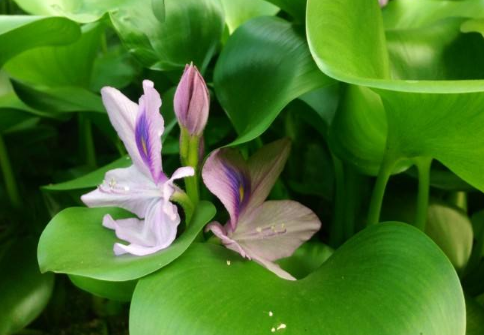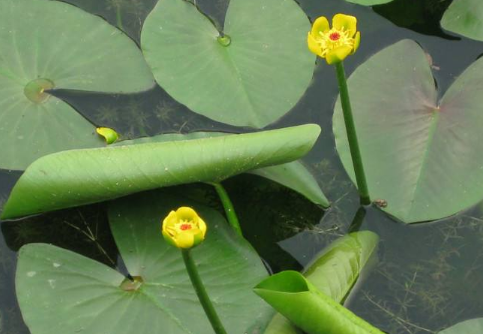Culture method of Phoenix Eye Blue
1. Temperature
Phoenix eye blue likes the warm environment, the suitable growth temperature is 18 ℃-23 ℃, the adaptability is very strong, the high temperature can also grow, more hardy, but the temperature below 10 ℃ will stop growing.

two。 Light
Phoenix Eye Blue likes the sun and receives at least four or five hours of light every day. Lack of light will affect photosynthesis. If you don't see light for a long time, your roots will rot.
3. Moisture content
Phoenix eye blue like to live in diving, spring and summer to often sprinkle water to the leaves, in order to increase air humidity, can change the water every two months.
External factors affecting the growth of Phoenix blue, culture methods of Phoenix blue and matters needing attention
Phoenix eye blue, known as the "lavender Corolla to beautify the world", is a plant whose stamens look like eyes. So, do you want to know the planting techniques of Phoenix Eye Blue? Do you want to raise Phoenix eye blue? Today, the editor, next we will come to know this plant Phoenix Eye Blue.
Culture method of Phoenix Eye Blue
Temperature
Phoenix blue likes the warm environment, and the suitable growth water temperature is 18 ℃-23 ℃. It can grow even if it is more than 35 ℃, but it will stop growing when it is less than 10 ℃. It has certain cold tolerance.
Light
Phoenix eye blue has a high demand for light, and the longer the light time, the more exuberant the photosynthesis.
Therefore, it is necessary to keep 4mi light for five hours a day, especially in spring, if it is placed in a place that is too shady, Phoenix eye blue can not see and see through the light, it will rot and die.
Watering
To maintain a relatively fixed air humidity, it is best to be between 70% and 80%. The temperature rises gradually in spring and water evaporation begins to become faster. Water should be often sprayed to Phoenix eye blue to increase air humidity.
Usually change the water once every two months, the temperature difference of the water is not too big.
Matters needing attention in the Culture of Phoenix Eye Blue
Pay attention to control the room temperature
The temperature difference between day and night should not exceed 2 ℃. When the temperature is 4 ℃-5 ℃, it can survive, but it can not be lower than 0 ℃. Generally, the water temperature should be above 5 ℃.
Regular ventilation
Every day to adhere to ventilation, keep the indoor air fresh, to the late April, all the doors and windows can be opened during the day, and then closed in the afternoon.
Pay attention to fertilization during seed conservation
In addition to applying sufficient base fertilizer before seed conservation, fertilizer should also be applied frequently during seed conservation, preferably with rotten human feces and urine, diluted by 1:20 concentration. Do not sprinkle directly on the seedlings when topdressing.
This is what I know about aquatic plants today. I hope it will be helpful for you to read this article. If you want to know more about bulb flowers, please continue to pay attention to our succulent flower beds. We will provide you with more relevant content for the first time!
Culture methods and matters needing attention of Phoenix Eye Blue
Temperature of Culture method of Phoenix Eye Blue
Phoenix blue likes the warm environment, and the suitable growth water temperature is 18 ℃-23 ℃. It can grow even if it is more than 35 ℃, but it will stop growing when it is less than 10 ℃. It has certain cold tolerance.
Light
Phoenix eye blue has a high demand for light, and the longer the light time, the more exuberant the photosynthesis.
Therefore, it is necessary to keep 4mi light for five hours a day, especially in spring, if it is placed in a place that is too shady, Phoenix eye blue can not see and see through the light, it will rot and die.
Watering
To maintain a relatively fixed air humidity, it is best to be between 70% and 80%. The temperature rises gradually in spring and water evaporation begins to become faster. Water should be often sprayed to Phoenix eye blue to increase air humidity.
Usually change the water once every two months, the temperature difference of the water is not too big.
Matters needing attention in the Culture of Phoenix Eye Blue pay attention to controlling Room temperature
The temperature difference between day and night should not exceed 2 ℃. When the temperature is 4 ℃-5 ℃, it can survive, but it can not be lower than 0 ℃. Generally, the water temperature should be above 5 ℃.
Regular ventilation
Every day to adhere to ventilation, keep the indoor air fresh, to the late April, all the doors and windows can be opened during the day, and then closed in the afternoon.
Pay attention to fertilization during seed conservation
In addition to applying sufficient base fertilizer before seed conservation, fertilizer should also be applied frequently during seed conservation, preferably with rotten human feces and urine, diluted by 1:20 concentration. Do not sprinkle directly on the seedlings when topdressing.
- Prev

The method of culturing Brassica juncea
1. In substrate cultivation, common pond mud can be selected as the substrate, which should not be too fertile, otherwise the branches and leaves will grow too dense and affect flowering. two。 Light vegetables usually ensure sufficient light, can be placed in the courtyard care, without shading can also grow very well. 3. Brassica campestris has a great demand for water.
- Next

The Propagation method of Rabdosia angustifolia
The seeds of sowing and propagation have a hard shell. Soak the seeds in water or on a wet towel before planting, and wait for the seeds to crack and sprout gradually. Generally, the seeds can be sowed in the first ten days of April, and the lotus pond mud can be selected for culture. The seeds are evenly sprinkled in the soil, watered thoroughly, covered with glass and insulated, and floating leaves can grow in a month.
Related
- Fuxing push coffee new agricultural production and marketing class: lack of small-scale processing plants
- Jujube rice field leisure farm deep ploughing Yilan for five years to create a space for organic food and play
- Nongyu Farm-A trial of organic papaya for brave women with advanced technology
- Four points for attention in the prevention and control of diseases and insect pests of edible fungi
- How to add nutrient solution to Edible Fungi
- Is there any good way to control edible fungus mites?
- Open Inoculation Technology of Edible Fungi
- Is there any clever way to use fertilizer for edible fungus in winter?
- What agents are used to kill the pathogens of edible fungi in the mushroom shed?
- Rapid drying of Edible Fungi

